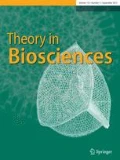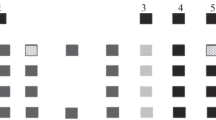Abstract
Relatively little is known about the evolutionary histories of most classes of non-protein coding RNAs. Here we consider Y RNAs, a relatively rarely studied group of related pol-III transcripts. A single cluster of functional genes is preserved throughout tetrapod evolution, which however exhibits clade-specific tandem duplications, gene-losses, and rearrangements.




Similar content being viewed by others
References
Bompfünewerer AF, Flamm C, Fried C, Fritzsch G, Hofacker IL, Lehmann J, Missal K, Mosig A, Müller B, Prohaska SJ, Stadler BMR, Stadler PF, Tanzer A, Washietl S, Witwer C (2005) Evolutionary patterns of non-coding RNAs. Theory Biosci 123:301–369
Chen X, Quinn AM, Wolin SL (2000) Ro ribonucleoproteins contribute to the resistance of Deinococcus radiodurans to ultraviolet resistance. Genes Dev 14:777–782
Christov CP, Gardiner TJ, Szüts D, Krude T (2006) Functional requirement of noncoding Y RNAs for human chromosomal DNA replication. Mol Cell Biol 26:6993–7004
Farris AD, O’Brien CA, Harley JB (1995) Y3 is the most conserved small RNA component of Ro ribonucleoprotein complexes in vertebrate species. Gene 154:193–198
Farris AD, Gross JK, Hanas JS, B HJ (1996) Genes for murine Y1 and Y3 Ro RNAs have class 3 RNA polymerase III promoter structures and are unlinked on mouse chromosome 6. Gene 174:35–42
Farris AD, Koelsch G, Pruijn GJ, van Venrooij WJ, Harley JB (1999) Conserved features of Y RNAs revealed by automated phylogenetic secondary structure analysis. Nucleic Acids Res 27:1070–8
Felsenstein J (1989) Phylip—phylogeny inference package (version 3.2). Cladistics 5:164–166
Green CD, Long KS, Shi H, Wolin SL (1998) Binding of the 60-kDa Ro autoantigen to Y RNAs: evidence for recognition in the major groove of a conserved helix. RNA 4:750–765
Hertel J, Lindemeyer M, Missal K, Fried C, Tanzer A, Flamm C, Hofacker IL, Stadler PF, Students of Bioinformatics Computer Labs 2004 and 2005 (2006) The expansion of the metazoan microRNA repertoire. BMC Genomics 7:25
van Horn DJ, Eisenberg D, O’Brien CA, Wolin SL (1995) Caenorhabditis elegans embryos contain only one major species of Ro RNP. RNA 1:293–303
Huson DH, Bryant D (2006) Application of phylogenetic networks in evolutionary studies. Mol Biol Evol 23:254–267
Lee Y, Jeon K, Lee JT, Kim S, Kim VN (2002) MicroRNA maturation: stepwise processing and subcellular localization. EMBO J 21:4663–4670
Lerner MR, Boyle JA, Hardin JA, Steitz JA (1981) Two novel classes of small ribonucleoproteins detected by antibodies associated with lupus erythematosus. Science 211:400–402
Maraia RJ, Sasaki-Tozawa N, Driscoll CT, Green ED, Darlington GJ (1994) The human Y4 small cytoplasmic RNA gene is controlled by upstream elements and resides on chromosome 7 with all other hY scRNA genes. Nucleic Acids Res 22:3045–3052
Maraia R, Sakulich AL, Brinkmann E, Green ED (1996) Gene encoding human Ro-associated autoantigen Y5 RNA. Nucleic Acids Res 24:3552–3559
Morgenstern B (1999) DIALIGN 2: improvement of the segment-to-segment approach to multiple sequence alignment. Bioinformatics 15:211–218
Mosig A, Sameith K, Stadler PF (2005) fragrep: efficient search for fragmented patterns in genomic sequences. Genomics Proteomics Bioinformatics 4:56–60
Nawrocki EP, Eddy SR (2007) Query-dependent banding (QDB) for faster RNA similarity searches. PLoS Comput Biol 2007. epub: doi:10.1371/journal.pcbi.0030056.eor
O’Brien CA, Margelot K, Wolin SL (1993) Xenopus Ro ribonucleoproteins: members of an evolutionarily conserved class of cytoplasmic ribonucleoproteins. Proc Natl Acad Sci USA 90:7250–7254
Perreault J, Noël JF, Brière F, Cousineau B, Lucier JF, Perreault JP, Boire G (2005) Retropeudogenes derived from human Ro/SS-A autoantigen-associated hY RNAs. Nucleic Acids Res 33:2032–2041
Perreault J, Perreault JP, Boire G (2007) The Ro associated Y RNAs in metazoans: evolution and diversification. Mol Biol Evol under review
Prochnik SE, Rokhsar DS, Aboobaker AA (2007) Evidence for a microRNA expansion in the bilaterian ancestor. Dev Genes Evol 217:73–77
Prujin GJM, Wingens PAETM, Peters SLM, Thijsen JPH, van Venrooij WJ (1993) Ro RNP associated Y RNAs are highly conserved among mammals. Biochim Biophys Acta 1216:395–401
Rutjes SA, Lund E, van der Heijden A, Grimm C, van Venrooij WJ, Pruijn GJM (2001) Identification of a novel cis-acting RNA element involved in nuclear export of hY RNAs. RNA 7:741–752
Sempere LF, Cole CN, McPeek MA, Peterson KJ (2006) The phylogenetic distribution of metazoan microRNAs: insights into evolutionary complexity and constraint. J Exp Zoolog B Mol Dev Evol 306B:575–588
Simons FH, Rutjes SA, van Venrooij WJ, Pruijn GJ (1996) The interactions with Ro60 and La differentially affect nuclear export of hY1 RNA. RNA 2:264–273
Tanzer A, Stadler PF (2004) Molecular evolution of a microRNA cluster. J Mol Biol 339:327–335
Teunissen SWM, Kruithof MJM, Farris AD, Harley JB, van Venrooij WJ, Pruijn GJM (2000) Conserved features of Y RNAs: a comparison of experimentally derived secondary structures. Nucleic Acids Res 28:610–619
Thompson JD, Higgs DG, Gibson TJ (1994) CLUSTALW: improving the sensitivity of progressive multiple sequence alignment through sequence weighting, position specific gap penalties, and weight matrix choice. Nucleic Acids Res 22:4673–4680
Weber MJ (2006) Mammalian small nucleolar RNAs are mobile genetic elements. PLoS Genet 2(12):e205
Zemann A, op de Bekke A, Kiefmann M, Brosius J, Schmitz J (2006) Evolution of small nucleolar RNAs in nematodes. Nucleic Acids Res 34:2676–2685
Acknowledgments
Discussions with Michael M. Müller are gratefully acknowledged. This work has been funded, in part, by the German DFG Bioinformatics Initiative BIZ-6/1-2.
Author information
Authors and Affiliations
Corresponding author
Rights and permissions
About this article
Cite this article
Mosig, A., Guofeng, M., Stadler, B.M.R. et al. Evolution of the vertebrate Y RNA cluster. Theory Biosci. 126, 9–14 (2007). https://doi.org/10.1007/s12064-007-0003-y
Received:
Accepted:
Published:
Issue Date:
DOI: https://doi.org/10.1007/s12064-007-0003-y




